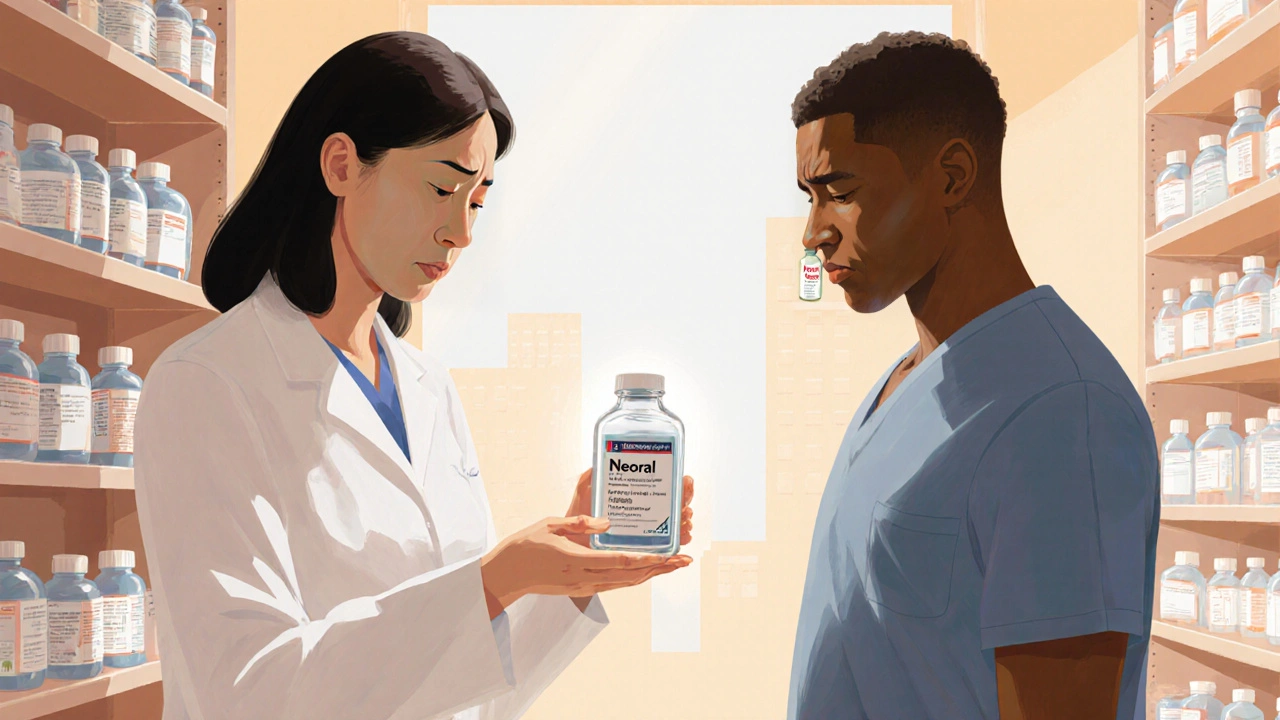Immunosuppressant Drug Comparison Tool
Select two drugs to compare their key attributes:
Neoral is a microemulsion formulation of cyclosporine A, an oral calcineurin inhibitor used to prevent organ‑transplant rejection and to treat severe autoimmune conditions such as psoriasis and rheumatoid arthritis. When doctors prescribe an immunosuppressant, they balance efficacy, safety, and how easy the drug is to monitor. That’s why a side‑by‑side look at the main alternatives matters - you’ll see which agent fits specific clinical scenarios and where Neoral shines or falls short.
Why Compare Neoral With Other Immunosuppressants?
Patients and clinicians face three recurring jobs:
- Identify the drug that delivers the strongest rejection‑preventing effect with the fewest long‑term complications.
- Understand how each medication is dosed, monitored, and adjusted.
- Choose a regimen that aligns with lifestyle, comorbidities, and cost.
Answering those jobs requires a clear picture of the pharmacology, indication spectrum, and safety profile of each option.
How Cyclosporine Works
Cyclosporine binds to cyclophilin, forming a complex that blocks the phosphatase activity of calcineurin. This inhibition stops the transcription of interleukin‑2 (IL‑2) and other cytokines essential for T‑cell activation. The result: a dampened immune response that reduces graft‑versus‑host activity and the inflammatory cascade in autoimmune skin and joint disease.
Key Attributes of Neoral
- Formulation: Microemulsion oil‑in‑water (enhances absorption).
- Bioavailability: Approx. 30‑45% (higher than the older Sandimmune capsule).
- Typical dosing: 3‑5mg/kg/day split into two doses for transplant patients; 2‑5mg/kg/day for dermatologic use.
- Therapeutic drug monitoring (TDM): Target trough levels 100‑400ng/mL (kidney) or 150‑300ng/mL (liver).
- Common side‑effects: Nephrotoxicity, hypertension, hyperlipidaemia, gum hyperplasia, tremor.
- Drug‑interaction profile: Metabolised by CYP3A4; strong inhibitors (ketoconazole) raise levels, inducers (rifampicin) lower them.
Major Alternatives at a Glance
Below are the six most widely used alternatives, each introduced with microdata for quick identification.
Mycophenolate mofetil is an antimetabolite that blocks inosine monophosphate dehydrogenase, curbing lymphocyte proliferation.
Azathioprine is a purine analogue that interferes with DNA synthesis in rapidly dividing cells, especially T and B lymphocytes.
Tacrolimus is a macrolide calcineurin inhibitor that binds FKBP‑12 and shares a similar pathway to cyclosporine but with higher potency.
Sirolimus is an mTOR inhibitor that blocks IL‑2‑driven cell cycle progression, used more often in kidney transplants.
Everolimus is a derivative of sirolimus with a shorter half‑life, approved for liver and heart transplants.
Belatacept is a fusion protein that blocks CD80/86‑CD28 co‑stimulation, offering a non‑calcineurin‑based option for kidney transplants.

Side‑by‑Side Comparison
| Drug | Class | Primary Indications | Bioavailability (or equivalent) | Typical Trough Target | Most notable side‑effects |
|---|---|---|---|---|---|
| Neoral (Cyclosporine) | Calcineurin inhibitor | Kidney, liver, heart transplants; severe psoriasis | 30‑45% | 100‑400ng/mL | Nephrotoxicity, hypertension, gum hyperplasia |
| Mycophenolate mofetil | Antimetabolite | Kidney, heart, liver transplants; lupus nephritis | ~90% | 1‑3µg/mL (AUC) | GI upset, leukopenia, infection risk |
| Azathioprine | Purine analogue | Kidney transplants, IBD, rheumatoid arthritis | ~50% | Therapeutic dosing 1‑3mg/kg/day (no TDM) | Myelosuppression, liver toxicity, pancreatitis |
| Tacrolimus | Calcineurin inhibitor | Kidney, liver, pancreas transplants; atopic dermatitis | ~25‑30% | 5‑15ng/mL | Nephrotoxicity, neurotoxicity, diabetes |
| Sirolimus | mTOR inhibitor | Kidney transplants (CNI‑sparing), stent‑coated devices | ~14% | 5‑15ng/mL | Hyperlipidaemia, delayed wound healing, anemia |
| Everolimus | mTOR inhibitor | Liver, heart, lung transplants; certain cancers | ~30% | 3‑8ng/mL | Stomatitis, hyperglycaemia, infections |
| Belatacept | Co‑stimulation blocker | Kidney transplant (CNI‑free regimen) | IV infusion (100% bioavailability) | Dosage based on weight; no trough target | PTLD (post‑transplant lymphoproliferative disorder), infusion reactions |
Decision Criteria: When to Pick Neoral
Use the following checklist to decide if Neoral is the right start:
- Transplant type: Proven efficacy in kidney, liver, and heart grafts; especially when a calcineurin pathway is preferred.
- Patient renal reserve: If baseline kidney function is good, the nephrotoxic risk can be managed with tight TDM.
- Drug‑interaction landscape: Patients on multiple CYP3A4 substrates may benefit from Neoral’s well‑characterised interaction data.
- Formulation preference: The microemulsion capsule offers more predictable absorption than older formulations.
- Cost considerations: Generic cyclosporine is cheaper than brand‑name tacrolimus in many NHS formularies, but the price gap is narrowing.
If any of these points raise red flags-especially severe pre‑existing kidney disease-a non‑calcineurin alternative (e.g., mycophenolate, sirolimus, or belatacept) might be safer.
Practical Tips for Managing Neoral Therapy
- Baseline labs: Serum creatinine, fasting lipids, magnesium, and blood pressure before starting.
- Monitoring frequency: Check trough levels twice weekly for the first month, then weekly to bi‑weekly once stable.
- Dietary advice: Avoid grapefruit and high‑fat meals around the dose; they can alter absorption.
- Side‑effect mitigation: Use chlorhexidine mouthwash for gum hyperplasia; prescribe ACE inhibitors if hypertension develops.
- Switching strategy: When converting from cyclosporine to tacrolimus, use a 1:0.2 conversion ratio and overlap for 3‑5 days with close monitoring.
Related Concepts and Connected Topics
Understanding Neoral in context helps you navigate the broader immunosuppression landscape. Key related ideas include:
- Therapeutic drug monitoring (TDM): Essential for cyclosporine, tacrolimus, sirolimus, and everolimus. Targets differ by organ type and time post‑transplant.
- Immunologic risk stratification: High‑risk recipients (e.g., previous graft loss) may need combined therapy (calcineurin inhibitor + antimetabolite).
- Drug‑induced nephrotoxicity: Shared across calcineurin inhibitors; prevention hinges on dose minimisation and blood pressure control.
- Infection prophylaxis: CMV, BK virus, and fungal infections rise with deeper immunosuppression; prophylactic antivirals are standard.
- Cost‑effectiveness analysis: Generic cyclosporine versus branded tacrolimus or biologic agents influences formulary decisions in the NHS.
TL;DR - Quick Takeaways
- Neoral is a calcineurin inhibitor with good transplant track record but notable nephrotoxicity.
- Alternatives (mycophenolate, azathioprine, tacrolimus, sirolimus, everolimus, belatacept) differ in mechanism, side‑effect profile, and monitoring needs.
- Pick Neoral when kidney function is reasonable, CYP3A4 interactions are manageable, and cost is a priority.
- Always use therapeutic drug monitoring and watch blood pressure, lipids, and renal labs.

Frequently Asked Questions
What is the main difference between Neoral and Tacrolimus?
Both are calcineurin inhibitors, but tacrolimus binds FKBP‑12 and is roughly 3‑5 times more potent on a mg‑per‑mg basis. Tacrolimus tends to cause more neuro‑toxicity and diabetes, while cyclosporine (Neoral) is more associated with hypertension and gum overgrowth. Their trough targets differ (5‑15ng/mL for tacrolimus vs 100‑400ng/mL for cyclosporine), and tacrolimus has slightly lower oral bioavailability.
Can I switch from Neoral to Mycophenolate mofetil?
Yes, many centres use a “CNI‑free” protocol after the early post‑transplant period. The switch usually involves tapering Neoral over 1‑2 weeks while starting mycophenolate at 1‑2g twice daily. Close monitoring of renal function and signs of rejection is essential during the transition.
Why does Neoral cause gum hyperplasia?
Cyclosporine stimulates fibroblast proliferation and collagen synthesis in gingival tissue, leading to overgrowth. Good oral hygiene, regular dental visits, and possibly switching to tacrolimus (which has a lower incidence) can mitigate the problem.
Is Neoral safe for patients with pre‑existing hypertension?
Cyclosporine can exacerbate blood pressure, so in hypertensive patients the dose should be kept at the lowest effective level and antihypertensive therapy adjusted early. Some clinicians prefer tacrolimus or an mTOR inhibitor in this subgroup to reduce the hypertension risk.
How often should I get cyclosporine trough levels checked?
During the first month post‑transplant, twice‑weekly draws are standard. Once stable, weekly to bi‑weekly checks are sufficient, unless dose changes, interacting drugs, or renal function shifts occur.
What are the cost differences between Neoral and its alternatives?
Generic cyclosporine (the active ingredient in Neolar) is usually cheaper than branded tacrolimus, especially in the UK NHS formulary. Mycophenolate and mTOR inhibitors can be more expensive, whereas azathioprine is inexpensive but less potent. Belatacept, being an IV biologic, carries the highest cost.

Julia Phillips
September 27, 2025 AT 01:47Neoral’s gum overgrowth is a nightmare if you’re not meticulous about oral hygiene.
Richa Punyani
October 15, 2025 AT 14:14When considering immunosuppression, the balance between efficacy and tolerability is paramount. Neoral offers a well‑established track record in renal and hepatic transplantation, yet its nephrotoxic potential cannot be ignored. Therapeutic drug monitoring should commence within the first fortnight to ensure trough levels remain within the 100‑400 ng/mL window. Moreover, clinicians must counsel patients on avoiding grapefruit juice and high‑fat meals, as these can markedly affect cyclosporine absorption.
Bhupendra Darji
November 3, 2025 AT 01:40From a practical standpoint, cyclosporine’s interaction profile is a double‑edged sword. On one hand, the CYP3A4 metabolism pathway is well‑characterised, allowing dose adjustments when co‑prescribed with inhibitors like ketoconazole. On the other, common drugs such as rifampicin can plunge levels, jeopardising graft protection. Regular renal function tests, coupled with lipid panels, help catch early signs of toxicity. If a patient presents with rising creatinine, consider the possibility of dose‑related nephrotoxicity before attributing it to other causes.
Robert Keter
November 21, 2025 AT 14:07Neoral, with its micro‑emulsion formulation, has long been a cornerstone in the armamentarium against graft rejection, and its pharmacokinetic quirks make it a fascinating subject for any transplant pharmacologist. The bioavailability of roughly 30‑45 % places it ahead of the ancient Sandimmune capsules, yet still behind the near‑complete absorption of mycophenolate mofetil, which whispers promises of more predictable exposure. When you dive into the trough targets-100‑400 ng/mL for kidneys, 150‑300 ng/mL for livers-the sheer breadth of the therapeutic window can feel both a blessing and a curse, demanding meticulous monitoring. The calcineurin inhibition pathway that Neoral shares with tacrolimus is a double‑edged sword; while both suppress IL‑2 transcription effectively, tacrolimus is touted as three to five times more potent on a milligram basis, often allowing lower dosing and, paradoxically, a different side‑effect profile. Nephrotoxicity, the notorious adversary of calcineurin inhibitors, manifests more subtly with cyclosporine, sometimes hiding behind modest rises in serum creatinine that are easily dismissed. Hypertension, another hallmark, can be exacerbated by cyclosporine’s effect on renal afferent arterioles, urging clinicians to pair it with ACE inhibitors or ARBs early in therapy. Gum hyperplasia, the flamboyant overgrowth that can turn a smile into a battlefield, is uniquely associated with cyclosporine, making dental hygiene a non‑negotiable part of the regimen. Meanwhile, the lipid disturbances-elevated cholesterol and triglycerides-add a metabolic twist that requires statin therapy in many patients. In contrast, mycophenolate’s gastrointestinal woes, ranging from nausea to severe ulceration, present a completely different compliance challenge. Azathioprine, the older purine analogue, is inexpensive but suffers from myelosuppression, demanding routine blood counts to avoid pancytopenia. Sirolimus and everolimus, the mTOR family members, shift the toxicity focus toward hyperlipidaemia and delayed wound healing, a trade‑off that some surgeons welcome when trying to spare kidneys from calcineurin insult. Belatacept, the biologic co‑stimulation blocker, eliminates calcineurin‑related nephrotoxicity altogether, yet introduces the specter of post‑transplant lymphoproliferative disorder, especially in Epstein‑Barr virus–negative recipients. Cost considerations also tilt the balance: generic cyclosporine remains a budget‑friendly option in many health systems, whereas the branded tacrolimus and newer mTOR inhibitors can strain formulary budgets. Ultimately, the decision to start Neoral hinges on a nuanced assessment of the patient’s baseline renal function, comorbidities like hypertension, and their ability to adhere to a rigorous monitoring schedule. If a patient can weather the blood pressure spikes and maintain diligent oral care, Neoral can still be a viable, cost‑effective choice in the modern transplant landscape.
Rory Martin
December 10, 2025 AT 02:34The pharmaceutical giants profit enormously from pushing cyclosporine’s nephrotoxicity while downplaying cheaper alternatives.
Regulators ignore the data that would favour mTOR inhibitors if they weren’t tied to big‑drug lobbyists.